
The Bottom Line
From what we have seen in our testing of the Spectrix Series of RAM. XPG is not afraid to look outside the box for answers as to what they think the market needs next when it comes to RGB LED DDR4. While the D40 has wings in the heat spreader design, the lighting is brilliant. The D41 took that a step further and removed the metal from around the top, which allowed for an even more brilliant display of lighting.
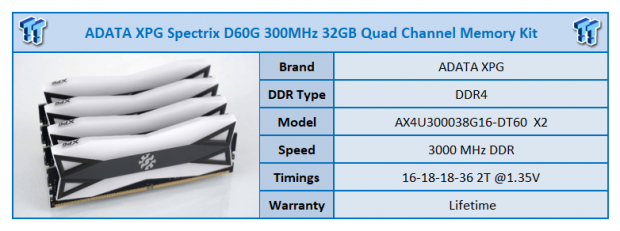
Lastly, in what we have already tested, were the D80 sticks, which not only delivered lighting through a crystal clear light bar, said bar was filled with fluid at an attempt at hybrid cooling. As if this was not enough options when it comes to styling and options within the RGB LED memory game, be prepared, as ADATA and their XPG division is taking it yet another step further.
Assuming we got our samples before the quad channel packaging was finished is a good reason why we received two 16GB kits of RAM rather than a quad-channel kit for testing, However, upon receipt we noticed that the factory seals on the packaging were broken, so that the kits could be tested to ensure compatibility and stability for this review. What we have in our hands is the Spectrix D60G, which may be the next evolution in RGB LED DDR4.
The pair of AX4U300038G16-DT60 packages we have run at 3000MHz with 16-18-18-36 2T timings, requiring 1.35V on one of the MXP 2.0 profiles. The second profile runs at 2666MHz, yet the timings are tighter at 16-16-16-36 2T, and they only use 1.25V to do so. The SPD profile is also a bit odd, as an initial boot of the kit results in 2666MHz with 19-19-19-43 2T timings, and the voltage is set to 1.35V. Not that anyone should expect an issue with the XPG kits, but should you run into one, warranty coverage is for a lifetime.
With the technical bits out of the way, there is still that one thing that sets the Spectrix D60G apart from all the rest. While many sticks, when lit, will show some LED coloration from the sides, it is usually relegated to just the top of the stick. There is an occasional oddity like the GeIL Dragon RAM with eyes that glow on the side, but this is still not in the same league. In the design of the Spectrix D60G, rather than metal heat spreaders, which are just there for style until you push voltage past 1.5V to the sticks anyways, XPG opts to use opaque plastic for the spreaders.
In doing so, while using a bit of metal trim on top of the plastic, and installing the surface mounted LEDs facing down to the gold tabs on the modules, it allows them to make the entire side glow as well as the typical light show across the top.
While this may not be for everyone, for those who desire the latest and greatest in bling, or those with horizontal mounted motherboards where the view of the RAM will display the sides proudly, there is nothing else out there today that can compete with the complete coverage of RGB LEDs that ADATA has delivered right now. There is also another think we found to be new to the market, but that little tidbit will be held for later on in the review, but we can say we are impressed with what we found under the spreaders as well.
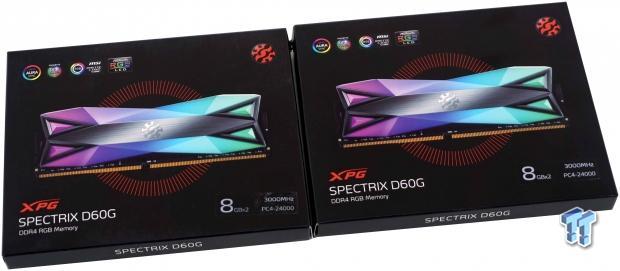
The packaging for the Spectrix D60G is black, which allows the colorized images of the RAM in the center to draw your attention to the side lighting capabilities. Across the top, we see compatibility with the major motherboard RGB software, and to the right is the Spectrix logo. Across the bottom is the XPG Spectrix D60G DDR4 RGB Memory naming, and to the right we see a sticker displaying the 16GB density and 3000MHz speed of each kit we have been sent.
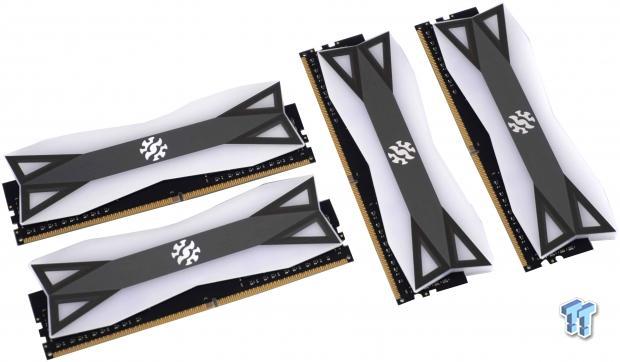
It is hard to do these sticks justice in images, as the white plastic flattens out, where the "diamond-cut" designs are muted and tough to discern. On top of the plastic are aluminum appliques which are brushed along the gray bits, textured on the black triangles, and the logo in the center is left in its natural state. Black PCBs are a plus to the aesthetic as well, but you do have to wait until we get them in the motherboard and power them to get the full effect of what the Spectrix D60G is all about.
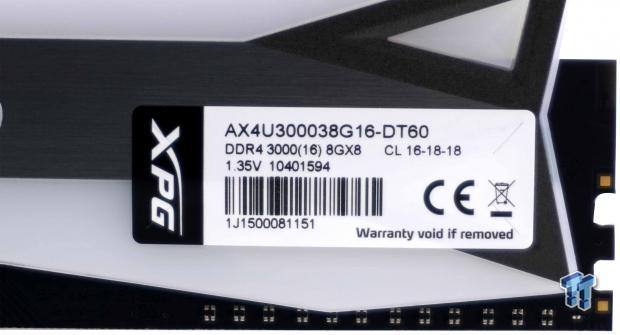
On the viewable side of the sticks are stickers placed there by XPG to more readily get to the information they offer. The stickers provides the AX4U300038G16-DT60 part number, they show the fastest XMP 2.0 profiles 3000MHz speed and 16-18-18 timings, along with the 1.35V required. The serial numbers are also present, and while not a quad-channel kit, we did get 048, 049, 051, and 052 serial numbers in the two kits were have.

From the top, we can see a couple of things worth a mention. First, and most obvious, is the XPG name at what is the top of the RAM once installed. It is painted onto the plastic, and will be visible when the light display is active. The second thing you may notice is the two-piece design of the spreaders, where they are split down the middle lengthwise along the wing-like design hinting at others from the Spectrix Series.

While we do not advise this to users, we did remove the spreaders to have a look at what ICs were used. We find the ICs are marked ADATA 43NA-0616H HY19141, and Google has no information on the ICs. What are we to do, well we swapped CPUs and ran Thaiphoon Burner to find that XPG opted for the rumored Hynix M-die, H5AN8G8NMFR-VKC, which are supposed to be replacing the Samsung B-die as it ends production.

Once the RAM was in the motherboard and we were ready for the initial boot, we enabled the XMP 1 profile, exited, and what you see is what is shown on the stickers. Our Spectrix D60G is indeed running at 3000MHz with 16-18-18-36 2T timings, with voltages of 1.35VDIMM, 1.20VCCIO, and 1.20VCCSA.

What you now see is what happens if you were to enable XMP profile number two. The Spectrix D60G is now at 2666MHz, with 16-16-16-36 2T timings. However, when going back to BIOS to look at the voltages needed, we see VDIMM is at 1.25, the VCCIO drops to 1.10, and the VCCSA stays at 1.20.

While we did not expect much from this Hynix based kit at first, attempting to lower the timings showed that we were in the wrong mindset, as the M-die seems to be strong. At 3000MHz we had no issues with stability or testing with the timings dropped to 12-16-16-36 2T, and all we did was increase the VDIMM to 1.45V, as adding IO and SA voltages at this speed made no difference in what we were able to achieve.

Moving towards speed, we returned the RAM to the XMP1 profile, and started raising the RAM divider. This time use 1.45VDIMM, 1.30 VCCIO, and 1.30 VCCSA, and we Able to add 600MHz to the overall speed. Typically we see a couple or a few hundred megahertz headroom, but to get the Spectrix D60G to 3600MHz with minimal effort is quite pleasing to see.
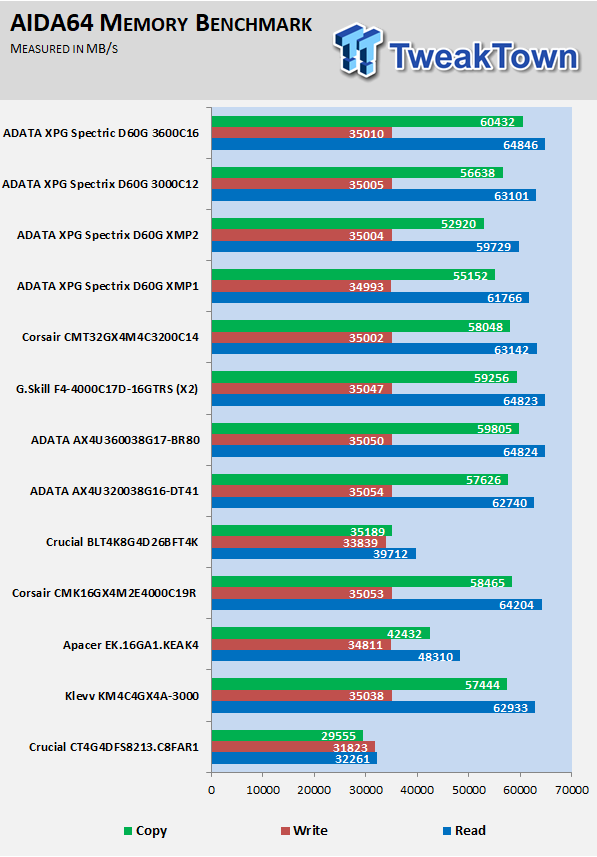
Fresh out of the box with XMP1 enabled, the results are good, but we do see that the much older KLevv kit, at the same speed, did produce better results. Using XMP2. At 2666MHz, compared to others in the chart, it handily beats the slower kits, and crushes the Crucial kit at the same speed. 3000MHz at CAS12, is a huge jump in performance, taking on those kits that are 3200MHz, and with the overall speed capped out at 3600MHz, even more, improvement is had, blowing past all kits in the chart.

SuperPi levels the playing field, and the results for the XMP1 profile is what we would expect to see, but again, slower than the KLevv. The XMP2 profile results in a time 6 seconds faster than the 2666MHz Crucials. Again the lowered timings helps, to the tune of 3200MHz in other sets in the chart, but at 3600MHz with XMP timings, The Spectrix D60G are again the fastest results in the chart.
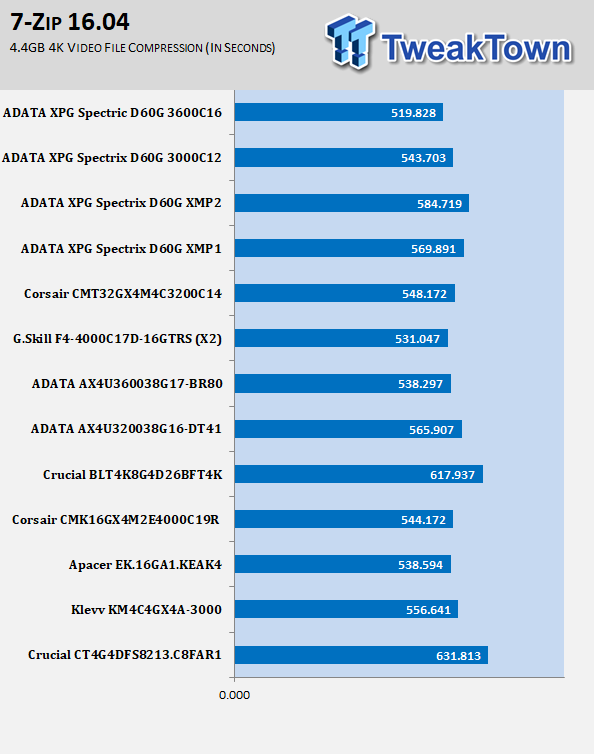
Our last test suite, 7-zip is a bit different when it comes to results. XMPO1 delivers performance on par with 3200MHz kits, and while XMP2 takes a hit, it annihilates the Crucial Ballistix by some 30 seconds. Lowering the timings is a great push for the top of the chart, but is still behind two other results, but once the speed is raised, it delivers one of the lowest times we have seen in 7-zip.
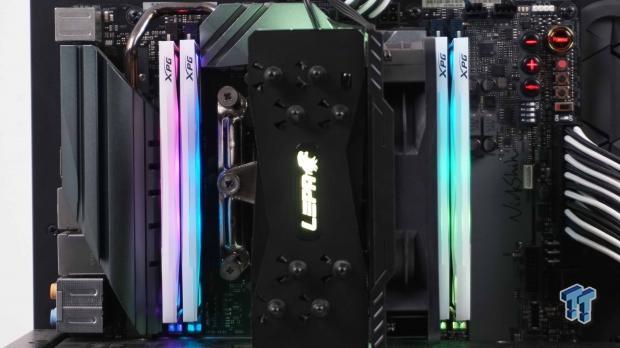
Typically we would reserve this image for the middle of the conclusion, but we have yet another image for that. Once powered, the Spectrix D60G take on a soft glow of fluid RGB colors streaming from top to bottom. Of course. All of this can be changed with motherboard software, but aesthetically, we have no complaints about the looks or the design including what is used as "heat spreader" material.
We have covered quite a bit in this review, and as we sort all of the things we have seen here in our head, we like what the Spectrix D60G brings to the table with its new look, and design implementations, such as plastic covers for the ICs, and of course, the new M-die Hynix that looks to kick ass and take names like the Samsung B-die was so well known for.
On top of that, this is the first memory to take RGB LEDs from just the top and the sides of the top, and devised a way to make sixty percent of the surface area glow. While ADATA and XPG may not be high on your list of RAM manufacturers, you may want to revise your list, as they are out setting the trend now, not coming up after someone else trying to break into an already filled space in the market.
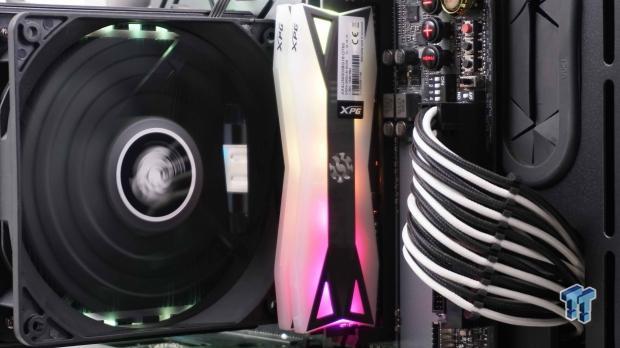
As you can see in the last image, The Spectrix D60G adds a flood of light around the RAM, onto the motherboard, the cooler, and even onto the wires and the top of the video card, which is something many others cannot claim. Even though there is all of the aforementioned factors to love this RAM for, performance is a tad lackluster in our opinion, unless you are an overclocker at heart.
That is where this DDR4 sings. Out of the box, with either of the XMP profiles used, the results show that there are better options out there for plug and play performance. However, once the gates are opened, the Spectrix D60G shows chart-topping results with little effort involved, and voltages that many users will feel comfortable with for long term usage.
With an overall drop in DDR4 prices, even since we reviewed our last kit of RAM, it is a good time to buy. Even though the MSRP of the 16GB kits was set to $189.99 originally, ADATA saw the price reductions and adapted, reducing the cost to just $119.99 per 16GB kit, or roughly $240 for the 32GB setup we tested in this review. Comparatively, to other 32GB kits of 3000MHz CAS16 kits on the market right now, it is this, or the TridentZ Royal you have to choose between. While we do love our Royal sticks we have in a daily driver, it does not offer the type of RGB illumination that ADATA brought to the table here.
Of course, there is much cheaper offerings without any LEDs, and some RAM in this group that goes as high at $700 or more too, which just makes the XPG Spectrix D60G all that much more appetizing. If you are one who wants the bleeding edge tech, and the Hynix M-die classifies perfectly here, one who wants the most RGB you can get into each device, or a diehard overclocker, you are going to want to get your hands-on this DDR4. As we said earlier; ADATA may not be on your radar when making a RAM purchase, but the Spectrix D60G proves that you need to move them up into the top two or three to look for currently.
Chad's DDR4 Dual-Channel Test System Specifications
- Motherboard: ASRock X299 OCF
- CPU: Intel Core i7 7800X - Buy from Amazon
- Cooler: LEPA NEOllusion - Buy from Amazon
- Video Card: ZOTAC GeForce GTX 970 AMP. Extreme Core
- Storage: Samsung XP941 256GB
- Case: Thermaltake Core P3 - Buy from Amazon
- Power Supply: Corsair RM750 - Buy from Amazon
- OS: Microsoft Windows 10 Home 64-bit - Buy from Amazon
- Software: CPU-Z 1.84.0 x64, Super Pi Mod 1.5XS, 7-Zip 16.04, AIDA64 Engineer 5.97.4600
Performance |
95% |
Quality |
97% |
Features |
100% |
Value |
98% |
Overall |
98% |
Based on some very strong Hynix M-die ICs with a ton of headroom left, not only are they amazing to look at, but lots of fun to tinker with as well. The Spectrix D60G is a step beyond what we are used to testing, and at a cost that does not reflect its exclusivity!

What's in Chad's PC?
- CPU: Intel Core i7 13700K
- MOTHERBOARD: ASUS ROG Maximus Z690 Hero Eva
- RAM: TEAM DDR5-7200 32GB
- GPU: ASUS GeForce RTX 3090 Eva
- SSD: addlink m.2 2TB
- OS: Windows 11 Pro
- COOLER: Fractal Lumen S36
- PSU: be quiet! Dark Power Pro 1500W
- KEYBOARD: ASUS ROG Strix Scope TKL Electro Punk
- MOUSE: ASUS ROG Strix Impact Electro Punk
- MONITOR: ASUS ROG Swift OLED PG42UQ
Similar Content
Related Tags

